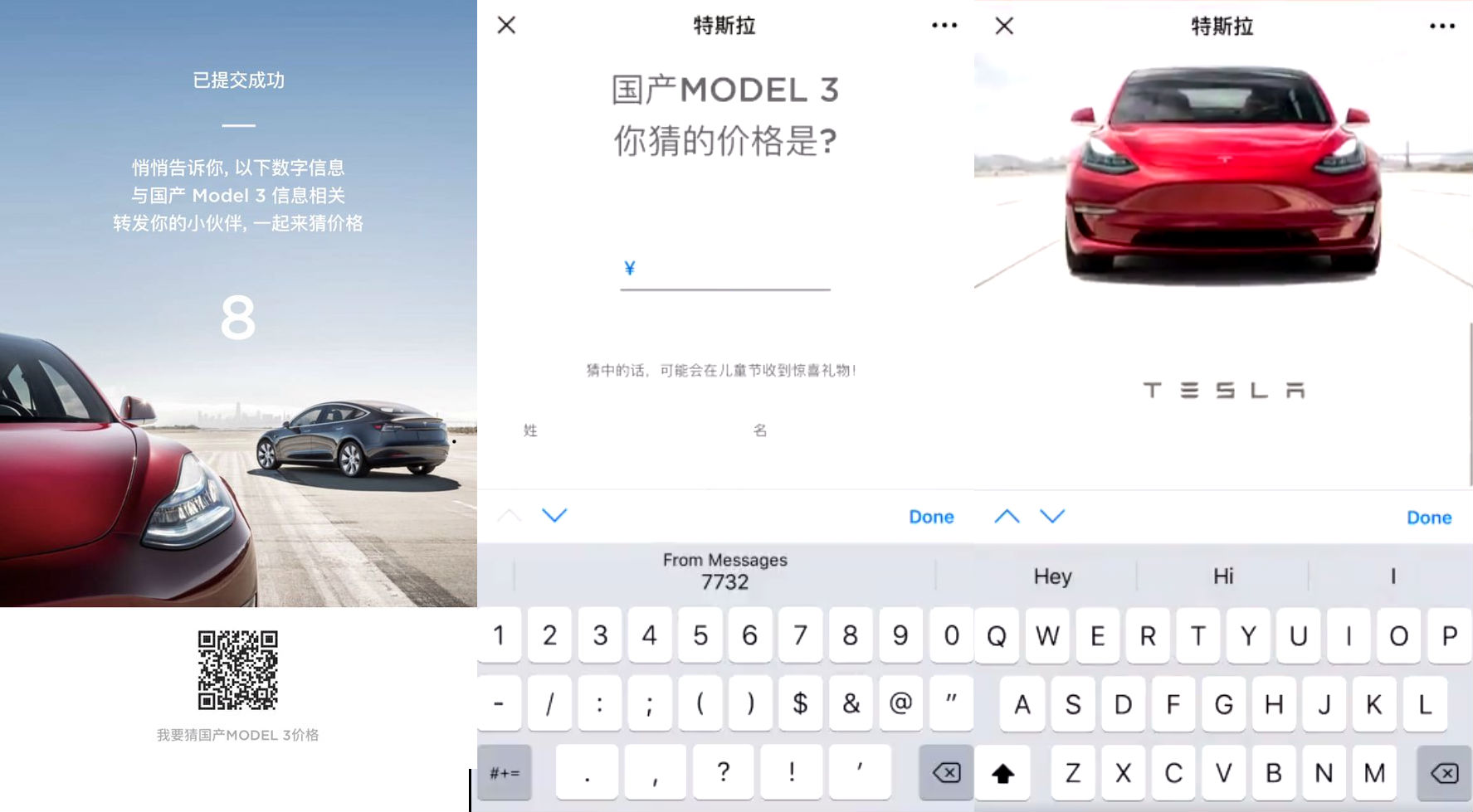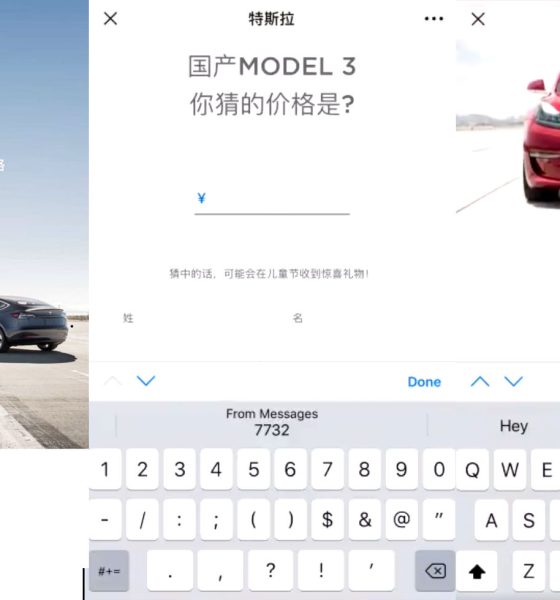

Investor's Corner
Tesla engages fans on Model 3 pricing in China ahead of special event
Yesterday, the Tesla community was saturated by news of a cryptic teaser emerging from China. The image, which included the words 储势,待发 (roughly translates to “building up momentum, getting ready to launch”) and a date (May 31, 2019), captured the Tesla community’s interest. It didn’t take long before speculations emerged about what the teaser could be referring to.
Today, more details about the upcoming May 31, 2019 event were released, with Tesla enthusiasts in China gaining access to a rather fun Model 3 guessing game. The rules of the game were simple. From a set of hint numbers (460, 225, 5.6, 3, 2, 8, 0, 27800 and 56000), Tesla fans could attempt to decode the price of locally-produced Model 3.
Tesla is already selling the Model 3 in China, though all vehicles are still imported from the United States, resulting in the electric sedans being hit by steep import tariffs. Locally-produced Model 3, which will be limited to affordable versions of the vehicle, are expected to compete in China’s mainstream EV market.
A recently published-Bloomberg report appears to shed more light on Tesla’s upcoming announcement on the 31st. Citing a source familiar with the matter, the publication noted that Tesla is considering pricing the locally-produced Model 3 between 300,000 RMB ($43,400) and 350,000 yuan ($50,600) before subsidies. The source reportedly declined to comment further about the specifics of the May 31 announcement, though it was mentioned that a final price for the China-made Model 3 is yet to be finalized.
A price of 300,000 RMB will still place the locally-made Model 3 above some popular local competitors such as the BYD Song, which has a starting price of 190,000 RMB (~$28,000), and the Xiaopeng G3, which starts at 160,000 RMB (~$23,000). Despite this, a 300,000 RMB price will make the locally made Model 3 significantly more affordable than the variants of the vehicle available for the country today, such as the Standard Plus RWD version, which currently starts at 377,000 RMB (~$54,500).
An announcement of the official prices for the locally made Model 3 on May 31 could have notable effects on Tesla’s sales in China. On the one hand, revealing a more affordable version of the electric sedan this early could result in some potential customers holding out for the locally-made vehicles’ arrival later this year. On the other hand, reports from China suggest that a significant number of orders in the country are for the Long Range RWD version of the vehicle, which is a variant that will not be produced in Gigafactory 3. With this in mind, buyers of Tesla’s electric cars that are looking for long-range options will likely be unaffected by the May 31 announcement.
Gigafactory 3 is expected to complete the construction of its factory shell by the end of May. Following this, the facility is expected to undergo ground hardening in June. These will be followed by pipeline communication, equipment stationing, equipment commissioning, and trial production runs, which, barring any unexpected delays, could start as early as September. The electric car factory is expected to produce affordable versions of the Model 3 and later, the Model Y SUV.

Investor's Corner
Tesla stock closes at all-time high on heels of Robotaxi progress

Tesla stock (NASDAQ: TSLA) closed at an all-time high on Tuesday, jumping over 3 percent during the day and finishing at $489.88.
The price beats the previous record close, which was $479.86.
Shares have had a crazy year, dipping more than 40 percent from the start of the year. The stock then started to recover once again around late April, when its price started to climb back up from the low $200 level.
This week, Tesla started to climb toward its highest levels ever, as it was revealed on Sunday that the company was testing driverless Robotaxis in Austin. The spike in value pushed the company’s valuation to $1.63 trillion.
Tesla Robotaxi goes driverless as Musk confirms Safety Monitor removal testing
It is the seventh-most valuable company on the market currently, trailing Nvidia, Apple, Alphabet (Google), Microsoft, Amazon, and Meta.
Shares closed up $14.57 today, up over 3 percent.
The stock has gone through a lot this year, as previously mentioned. Shares tumbled in Q1 due to CEO Elon Musk’s involvement with the Department of Government Efficiency (DOGE), which pulled his attention away from his companies and left a major overhang on their valuations.
However, things started to rebound halfway through the year, and as the government started to phase out the $7,500 tax credit, demand spiked as consumers tried to take advantage of it.
Q3 deliveries were the highest in company history, and Tesla responded to the loss of the tax credit with the launch of the Model 3 and Model Y Standard.
Additionally, analysts have announced high expectations this week for the company on Wall Street as Robotaxi continues to be the focus. With autonomy within Tesla’s sights, things are moving in the direction of Robotaxi being a major catalyst for growth on the Street in the coming year.
Elon Musk
Tesla needs to come through on this one Robotaxi metric, analyst says
“We think the key focus from here will be how fast Tesla can scale driverless operations (including if Tesla’s approach to software/hardware allows it to scale significantly faster than competitors, as the company has argued), and on profitability.”

Tesla needs to come through on this one Robotaxi metric, Mark Delaney of Goldman Sachs says.
Tesla is in the process of rolling out its Robotaxi platform to areas outside of Austin and the California Bay Area. It has plans to launch in five additional cities, including Houston, Dallas, Miami, Las Vegas, and Phoenix.
However, the company’s expansion is not what the focus needs to be, according to Delaney. It’s the speed of deployment.
The analyst said:
“We think the key focus from here will be how fast Tesla can scale driverless operations (including if Tesla’s approach to software/hardware allows it to scale significantly faster than competitors, as the company has argued), and on profitability.”
Profitability will come as the Robotaxi fleet expands. Making that money will be dependent on when Tesla can initiate rides in more areas, giving more customers access to the program.
There are some additional things that the company needs to make happen ahead of the major Robotaxi expansion, one of those things is launching driverless rides in Austin, the first city in which it launched the program.
This week, Tesla started testing driverless Robotaxi rides in Austin, as two different Model Y units were spotted with no occupants, a huge step in the company’s plans for the ride-sharing platform.
Tesla Robotaxi goes driverless as Musk confirms Safety Monitor removal testing
CEO Elon Musk has been hoping to remove Safety Monitors from Robotaxis in Austin for several months, first mentioning the plan to have them out by the end of 2025 in September. He confirmed on Sunday that Tesla had officially removed vehicle occupants and started testing truly unsupervised rides.
Although Safety Monitors in Austin have been sitting in the passenger’s seat, they have still had the ability to override things in case of an emergency. After all, the ultimate goal was safety and avoiding any accidents or injuries.
Goldman Sachs reiterated its ‘Neutral’ rating and its $400 price target. Delaney said, “Tesla is making progress with its autonomous technology,” and recent developments make it evident that this is true.
Investor's Corner
Tesla gets bold Robotaxi prediction from Wall Street firm
Last week, Andrew Percoco took over Tesla analysis for Morgan Stanley from Adam Jonas, who covered the stock for years. Percoco seems to be less optimistic and bullish on Tesla shares, while still being fair and balanced in his analysis.

Tesla (NASDAQ: TSLA) received a bold Robotaxi prediction from Morgan Stanley, which anticipates a dramatic increase in the size of the company’s autonomous ride-hailing suite in the coming years.
Last week, Andrew Percoco took over Tesla analysis for Morgan Stanley from Adam Jonas, who covered the stock for years. Percoco seems to be less optimistic and bullish on Tesla shares, while still being fair and balanced in his analysis.
Percoco dug into the Robotaxi fleet and its expansion in the coming years in his latest note, released on Tuesday. The firm expects Tesla to increase the Robotaxi fleet size to 1,000 vehicles in 2026. However, that’s small-scale compared to what they expect from Tesla in a decade.
Tesla expands Robotaxi app access once again, this time on a global scale
By 2035, Morgan Stanley believes there will be one million Robotaxis on the road across multiple cities, a major jump and a considerable fleet size. We assume this means the fleet of vehicles Tesla will operate internally, and not including passenger-owned vehicles that could be added through software updates.
He also listed three specific catalysts that investors should pay attention to, as these will represent the company being on track to achieve its Robotaxi dreams:
- Opening Robotaxi to the public without a Safety Monitor. Timing is unclear, but it appears that Tesla is getting closer by the day.
- Improvement in safety metrics without the Safety Monitor. Tesla’s ability to improve its safety metrics as it scales miles driven without the Safety Monitor is imperative as it looks to scale in new states and cities in 2026.
- Cybercab start of production, targeted for April 2026. Tesla’s Cybercab is a purpose-built vehicle (no steering wheel or pedals, only two seats) that is expected to be produced through its state-of-the-art unboxed manufacturing process, offering further cost reductions and thus accelerating adoption over time.
Robotaxi stands to be one of Tesla’s most significant revenue contributors, especially as the company plans to continue expanding its ride-hailing service across the world in the coming years.
Its current deployment strategy is controlled and conservative to avoid any drastic and potentially program-ruining incidents.
So far, the program, which is active in Austin and the California Bay Area, has been widely successful.








